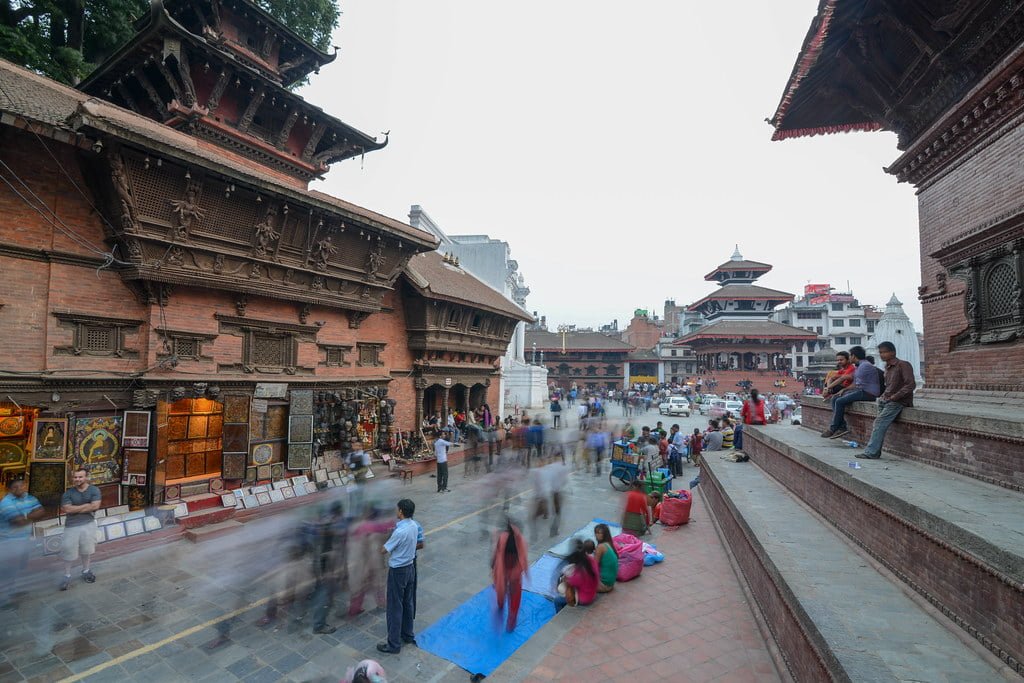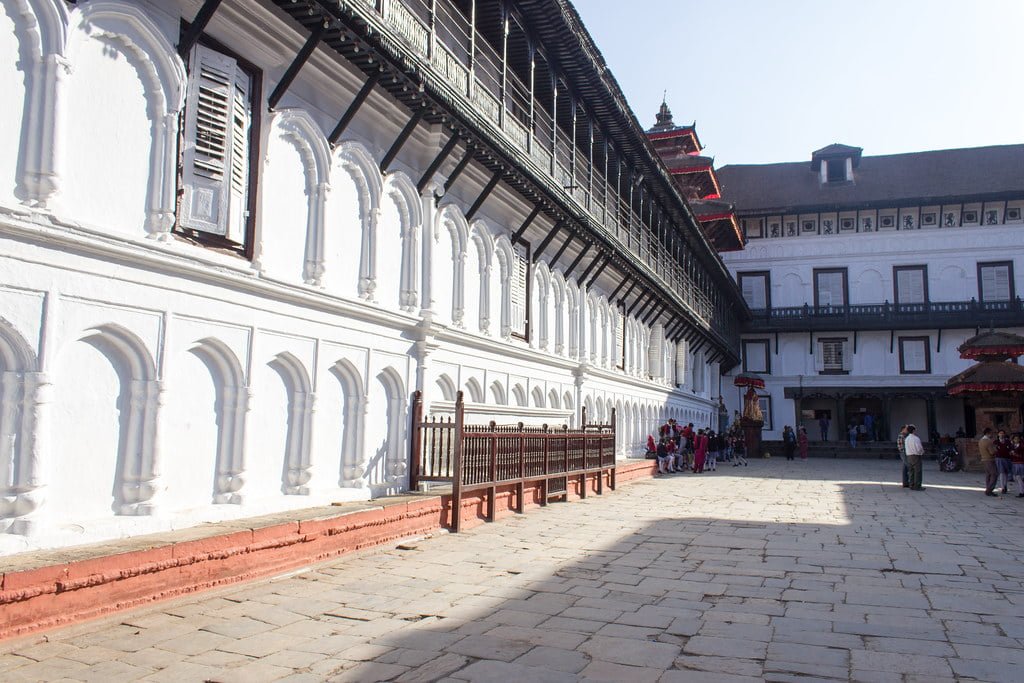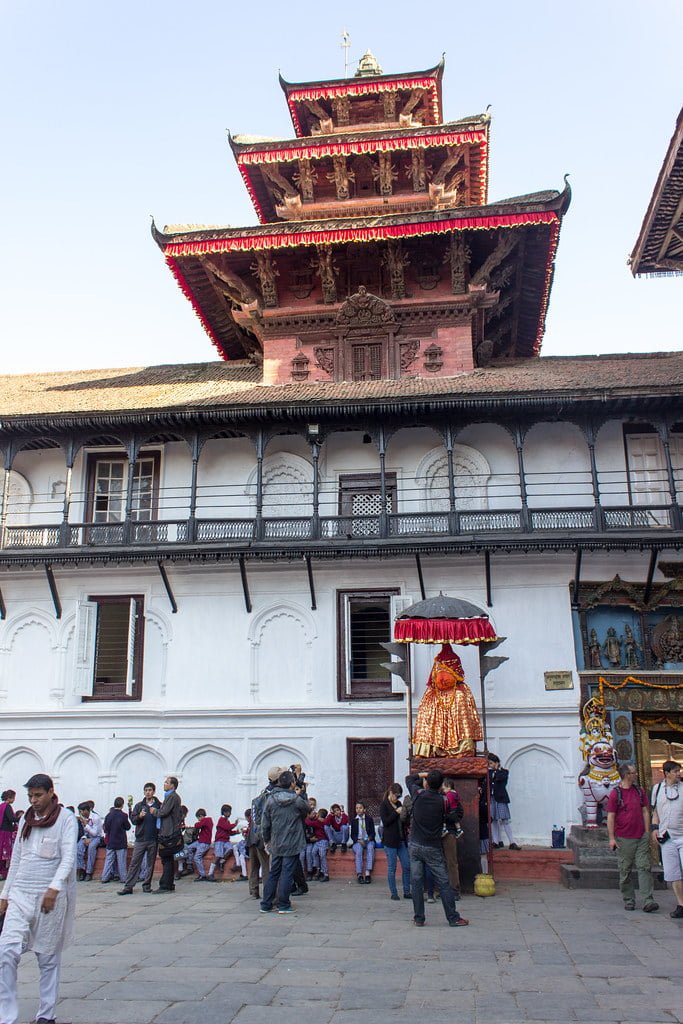Hanuman Dhoka Palace: A Timeless Symbol of Nepalese Royalty
The Hanuman Dhoka Palace, located in central Kathmandu, Nepal, is a magnificent testament to the rich history and royal heritage of the country. Serving as the Royal Palace of the Malla kings and later the Shah dynasty, this historic complex is a timeless symbol of Nepalese royalty.
Dating back to the 4th to 8th century AD, Hanuman Dhoka Palace has witnessed centuries of dynastic rule and political transformations. Its name originates from the stone image of Hanuman, the Hindu deity, that sits near the main entryway. In the Nepali language, ‘Dhoka’ means door or gate, emphasizing the importance and grandeur of this place.
Despite being severely damaged during the devastating earthquake in 2015, the palace has been extensively restored, allowing visitors to once again experience the splendor of its courtyards and museums. The restoration efforts have ensured that the architectural magnificence and historical significance of Hanuman Dhoka Palace are preserved for future generations to admire.
As you stroll through the palace grounds, you will be captivated by the intricate details and cultural significance of the structures. The palace complex consists of numerous buildings, each with its own historical and architectural importance. From the stunning courtyards to the exquisite temples, Hanuman Dhoka Palace showcases the artistic brilliance of Nepalese craftsmanship.
One of the notable features within the palace complex is the Kasthamandap Temple. Allegedly founded in the 12th century, this Buddhist monastery has stood in its present form since 1409. Its ancient origins and spiritual ambiance add a sense of tranquility and reverence to the palace grounds.
Another highlight of Hanuman Dhoka Palace is the statue of the king, which faces the Degu Taleju temple room. The statue, along with depictions of the king’s wives and sons, provides a glimpse into the lives of the Malla kings and their royal lineage. The statues, characterized by the kneeling position, offer a unique contrast to the more upright and martial poses of subsequent kings.
At the entrance of the palace, you will be greeted by the stone image of Hanuman, adorned in red robes and layers of sindhur and mustard oil on his face. Known as the Monkey King of Ramayana, Hanuman is believed to bring martial victory and ward off evil spirits and diseases. His presence at the gate serves as a guardian and protector of the palace.
Visiting Hanuman Dhoka Palace is not just an exploration of history, but also a journey into the heart of Nepalese culture and tradition. It is a testament to the enduring legacy of the Malla kings and the Shah dynasty, whose rule shaped the identity of Nepal.
Historical Background of Hanuman Dhoka Palace
The Hanuman Dhoka Palace, located in Kathmandu, Nepal, has a rich historical background that dates back to the 4th to 8th century AD. Originally built as the royal palace for the Malla kings and later for the Shah dynasty, this magnificent complex consists of ancient structures, some of which are as old as the mid-16th century.
The name “Hanuman Dhoka” is derived from an antique idol of Lord Hanuman, the Hindu deity, that sits near the main entrance of the palace. “Dhoka” means door or gate in Nepali, symbolizing the grand entrance to this historic site.
Spread over an area of 5 acres, the palace had to endure significant damage during the devastating earthquake in 2015. However, extensive restoration efforts have brought back its former glory, allowing visitors to now access its stunning courtyards and museums.
Hanuman Dhoka Palace holds immense cultural and historical significance. It served as the royal residence for several generations of rulers, witnessing the rise and fall of dynasties. The palace complex showcases a unique blend of architectural styles influenced by Hindu and Buddhist traditions, reflecting the cultural diversity of Nepal.
In addition to being a royal residence, Hanuman Dhoka Palace was also a center of governance and administration, with various government offices and courts located within its premises. It was a hub of political activity, witnessing the making of important decisions that shaped the history of Nepal.

Architectural Significance
Temples and Structures Within the Palace Grounds
One of the notable structures within the palace grounds is the Gaddi Baithak. Standing out from its neighboring buildings with its unique architectural style, the Gaddi Baithak holds great importance. Inside, visitors can find a throne once used by kings, intricate chandeliers, and life-sized paintings of every Shah king throughout history. This building, although damaged, used to host governmental events and served as a place for important figures to worship the Kumari, the living goddess of Nepal.
Another significant temple that once stood proudly within the palace grounds is the Mahadeva Mandir, also known as Maju Deval. Sadly, the earthquake in 2015 destroyed much of this temple, leaving only the side stairs remaining. The Mahadeva Mandir held particular importance to dancers and singers, and its loss was deeply felt by the local community. Today, people often sit on the remaining stairs to rest and reflect, honoring the memory of this once revered temple.
The Hanuman Dhoka Palace itself is a series of structures encompassing five acres of the palace grounds. This complex includes the Royal Palace, Taleju Temple, Hanuman Gate, the Panch Mukhi Hanuman Temple, and the Basantapur Tower. The palace derives its name from the statue of the Hindu deity Hanuman, who guards the front door. The oldest part of the palace is the eastern wing and its courtyards, which were built in the mid-1500s and later expanded by King Pratap Malla. The addition of towers occurred in 1768, further enhancing the grandeur of the palace.
Throughout history, various kings have contributed to the construction and expansion of the palace and its surrounding structures. The current Old Royal Palace consists of multiple yards, halls, temples, buildings, and towers, each reflecting the architectural styles and influences of different periods. Although the existing buildings do not date back to the original palace built in 500 AD, they still hold immense historical significance.

Influence of Malla Kings and Prithvi Narayan Shah
The Malla kings, who ruled over Nepal from the 12th to the 18th century, were known for their patronage of art, culture, and architecture. They were passionate about preserving their cultural heritage and showcasing their power through grand palaces and temples. The Hanuman Dhoka Palace is a testament to their architectural prowess, with its intricate carvings, ornate decorations, and majestic courtyards.
One of the significant contributions of the Malla kings to the Hanuman Dhoka Palace is the Sun Dhara, a golden waterspout located in one of the courtyards. This waterspout was used by the kings for ablutions and was believed to have originated from Budanilkantha. It served as a symbol of the divine connection between the kings and the gods.
The Malla kings also built four watchtowers within the palace complex during the reign of King Prithvi Narayan Shah in 1768. These towers were strategically placed to provide a vantage point for surveillance and defense. They stand as a reminder of the Malla kings’ commitment to protecting their kingdom and maintaining their authority.
Speaking of Prithvi Narayan Shah, his influence on the Hanuman Dhoka Palace cannot be underestimated. He was the first king of the Shah dynasty and was responsible for unifying the various kingdoms of Nepal into a single nation. The Hanuman Dhoka Palace served as his residence until the late 1800s when the royal family relocated to the Narayanhiti Palace in Kathmandu.
Prithvi Narayan Shah’s vision and leadership transformed Nepal into a unified and sovereign nation. His presence in the Hanuman Dhoka Palace added to its historical significance and reinforced its role as a symbol of power and authority.
Tourism and Visitor Experience
Nasal Chowk
Located next to the Hanuman Temple near the entrance of Hanuman Dhoka in Kathmandu, Nasal Chowk is a courtyard that holds immense historical and cultural significance. This vibrant space gets its name from the beautiful image of Dancing Shiva, which can be found on the east side of the Chowk. As one enters Nasal Chowk, they are immediately greeted by an overwhelming collection of statues and sculptures that are sure to captivate any visitor.
One of the most revered statues in Nasal Chowk is that of Hanuman, a 17th-century sculpture covered in red clothes and holding an umbrella. This statue holds deep religious significance for the believers of Hinduism and is a symbol of strength and devotion. Alongside the statue of Hanuman, there is an intriguing sculpture of Lord Narasimha, the half-lion incarnation of Lord Vishnu, tearing apart the demon Hiranyakasipu. These statues and sculptures not only showcase the incredible craftsmanship of the artisans but also serve as a reminder of the rich mythological and spiritual traditions of Nepal.
Apart from the magnificent statues, Nasal Chowk also houses the nine-storey Basantpur Tower, an architectural marvel with intricately carved doorways, windows, and struts. The attention to detail in the carvings is truly remarkable and reflects the artistic mastery of the craftsmen of that era. The eastern wall of the tower is adorned with a golden image of Maha-Vishnu, adding a touch of grandeur to the open veranda. This image, protected under glass, is a testament to the reverence and devotion towards the deities in Nepalese culture.
Moreover, Nasal Chowk holds historical significance as it was the place where King Birendra was crowned in 1975. The courtyard witnessed an event of immense importance in the country’s history, further adding to its cultural significance. The area surrounding Nasal Chowk is also home to several notable structures, including the Panch Mukhi Hanuman, a five-story temple known for its unique architecture. Unfortunately, this temple, along with the temple housing the Malla king’s personal deity, is not open to the public.
One of the highlights of Nasal Chowk is the exquisite wood carvings that adorn the windows, doors, and walls of the buildings. The intricate designs depict various motifs, including naga (serpent), animals, and other decorations, showcasing the artistic prowess of the craftsmen of that era. The Lohan Chowk entranceway alone boasts over 20 different carved decorations, making it a visual delight for those interested in historical woodwork.

Tribhuvan Museum: A Glimpse into Nepal’s Royal Past
The Tribhuvan Museum, located within the historic Hanuman Dhoka Palace in Kathmandu, is a must-visit destination for lovers of history and those seeking to delve into the rich royal heritage of Nepal. Named after Tribhuvan Bir Bikram Shah, the man often referred to as the “father of the nation,” this museum offers a fascinating insight into the reign of the monarchs and the connections forged with the world beyond Nepal’s borders.
The museum is situated in the southern and western parts of the palace, near Nassal Chowk, and is home to an impressive collection of artifacts, collectibles, and items from the time of King Tribhuvan’s reign. However, it is important to note that while the exhibits are visually captivating, there is a lack of English translations or information about the significance of the items on display.
Visitors to the Tribhuvan Museum will have the opportunity to marvel at a wide array of historical treasures. The collection includes magnificent stone carvings, exquisite wooden temple carvings, jewel-studded ornaments used for coronations, weaponry, furniture, and a remarkable coin collection. These artifacts provide a glimpse into the opulence and grandeur of Nepal’s royal past.
One notable highlight of the museum is the recreation of the king’s bedroom and study, which offers a personal and intimate connection to King Tribhuvan himself. It contains his personal belongings, allowing visitors to step back in time and imagine the daily life of Nepal’s revered king.
The Tribhuvan Museum is just one of three museums located within the palace grounds. The King Mahendra Memorial Museum displays the thrones of King Mahendra, who reigned from 1955 until his death in 1972. Additionally, the Hanuman Dhoka Palace Museum serves as the primary museum in the complex, showcasing items and information from the Shah Dynasty and the history of Nepal as a whole.

Lohan Chowk & Mul Chowk: Insights into the Heart of Hanuman Dhoka
Lohan Chowk and Mul Chowk are two magnificent courtyards that lie within the historic Hanuman Dhoka complex in Kathmandu. These courtyards not only showcase the rich cultural heritage of Nepal but also provide a glimpse into the lives of the ancient rulers who once resided in this royal palace.
Located behind the Lohan courtyard, Mul Chowk holds significant historical importance as it is the oldest part of the royal palace. Built in 1564 by the Malla kings, it served as a venue for crowning new rulers and hosting marriage ceremonies. This courtyard is not accessible to the public; however, during the Dasain Festival, a traditional Hindu ceremony takes place here where the royal family sacrifices animals. This event, open to local Hindus for one day, adds to the cultural and religious significance of Mul Chowk.
Lohan Chowk, on the other hand, welcomes visitors through a breathtaking doorway adorned with intricate wood carvings. The centerpiece of this courtyard is the statue of the Elephant God Ganesh, symbolizing good fortune and prosperity. Lohan Chowk was a place where the Malla and Shah kings of Nepal spent their everyday lives. Four towers representing the major cities of the Kathmandu Valley stand tall at each corner of the chowk, adding a regal touch to the ambiance.
One of the highlights of Lohan Chowk is the detailed wood carvings that embellish the entranceway and its surroundings. Intricate designs, depictions of mythical creatures such as naga, and various other decorative elements can be observed on the windows, doors, and walls. In fact, it is estimated that there are over 20 different carved decorations in this courtyard alone, making it a haven for those interested in historical woodwork.
Moving beyond Lohan Chowk, visitors can explore the Tribhuvan Museum, named after the revered Tribhuvan, considered the father of the nation. This museum pays tribute to his efforts in restoring the reign of the monarchs and forging connections with the world in 1951. It provides an opportunity to delve deeper into the history of Nepal and gain insights into the country’s political evolution.
While exploring Lohan Chowk and Mul Chowk, visitors will also come across the Panch Mukhi Hanuman, a five-story temple dedicated to Hanuman, the Hindu monkey god. Unfortunately, this temple, along with the temple housing the personal deity of the Malla king, is not accessible to the public.
Mohankali Chowk & Sundari Chowk: Hidden Gems within Hanuman Dhoka
Nestled within the grand complex of Hanuman Dhoka in Kathmandu, Nepal, are two exquisite courtyards that hold historical and cultural significance – Mohankali Chowk and Sundari Chowk. While these areas are currently closed for post-earthquake reconstruction, they are set to reopen in the future, and when they do, visitors will be able to witness the beauty and charm they possess.
Mohankali Chowk, once a residence of the Malla kings, is a captivating courtyard that showcases the architectural brilliance of ancient Nepal. This area holds great importance as only the princes born within its boundaries were considered as heirs to the throne. Stepping into Mohankali Chowk, one is transported back in time as they explore the remnants of a bygone era. The highlight of this courtyard is the Sun Dhara, a stunning golden waterspout that is believed to have originated from Budanilkantha. This sacred water source was once used exclusively by the Malla kings, further adding to the historical significance of Mohankali Chowk.
Adjacent to Mohankali Chowk is another hidden gem within Hanuman Dhoka – Sundari Chowk. The name “Sundari” translates to “beautiful,” and true to its name, this courtyard is a true testament to the artistic finesse of Nepalese architecture. Sundari Chowk features doors and windows that adhere to traditional Nepalese architectural styles, showcasing the meticulous craftsmanship of the time. The courtyard is adorned with stone taps, adding to its aesthetic appeal. One cannot help but marvel at the intricate details and the rich symbolism embedded in every element of Sundari Chowk.
Both Mohankali Chowk and Sundari Chowk are small glimpses into the grandeur and grand history of Hanuman Dhoka. As visitors explore these courtyards, they can’t help but appreciate the dedication and craftsmanship that went into creating such magnificent spaces. These courtyards serve as a reminder of the rich cultural heritage of Nepal and the architectural prowess of the past.
Although currently closed for renovation, the reopening of Mohankali Chowk and Sundari Chowk is eagerly anticipated by locals and tourists alike. Once accessible, these hidden gems within Hanuman Dhoka will once again provide a serene and enchanting experience for all who visit, allowing them to immerse themselves in the history and beauty of Nepal’s architectural treasures.
